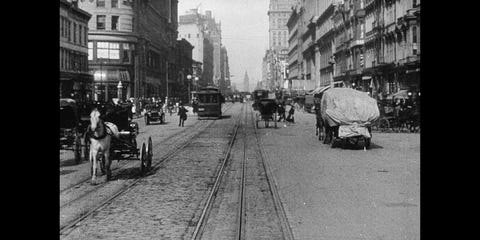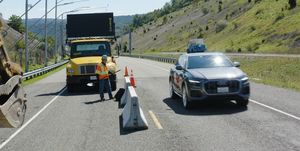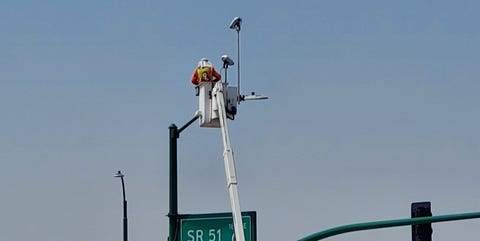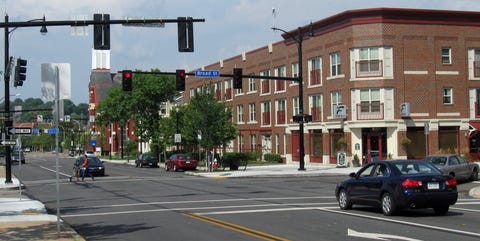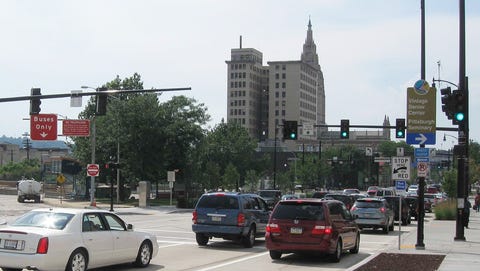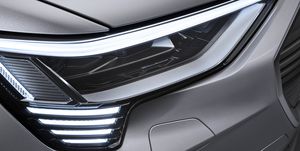Judging by a famous piece of footage showing a trip down Market Street in San Francisco circa 1906, traffic was a dangerous free-for-all in those days. Horses, cars and pedestrians, all getting in each other’s way. The mayhem was—only partially—tamed by the invention of the four-way, three-color traffic light 100 years ago in 1920 by Detroit policeman William Potts.
Two years later, traffic lights were beginning to use automatic timers and to interconnect, theoretically allowing motorists to proceed from one green light to another. But there has been amazingly little innovation since then and, until recently, not much was done to bring intersection control into the modern world of sensors, Lidar, cameras and artificial intelligence.
“Ninety-nine percent of the traffic lights in the world are not reacting in real time,” said Tal Kreisler, CEO of the Israel-based startup NoTraffic. “They’re using technology that hasn’t improved in 100 years, and they’re really not connected to anything.”
Many cities operate traffic management centers that are hives of activity akin to a busy urban air traffic control operation. But appearances are somewhat deceiving, given that the traffic engineers have limited tools available to manipulate their signal networks to respond in real time. They can make manual changes for congestion and other roadway problems they see, but they can’t make the traffic signals any smarter.
By digitizing the traffic light and getting it fully into the world of Big Data, companies like NoTraffic and Pittsburgh-based Surtrac say they can offer major environmental and congestion benefits. Surtrac, working with technology developed at Carnegie Mellon University (CMU), claims to be able to reduce travel times by 25 percent, signal wait times by 40 percent, stops by 30 percent and emissions by 20 percent.
Smart traffic lights gather information from sensors placed at intersections and regularly update light timing based on actual conditions, rather than being limited to pre-set time spans based on historical averages. If you’ve ever sat at a light that stayed stubbornly red when there wasn’t any traffic in sight—or fruitlessly pushed the ancient, painted-over “Push to Walk” button—you’ve experienced the frustration of doing things the old way. Ideally, the intersections will also be able to communicate with the cars and trucks passing through, giving them invaluable information (garnered from the whole light network) about what to expect ahead.
NoTraffic installs AI sensors and its own optimization engine (which reads the data and tells the light what to do) at each intersection. The company has U.S. pilot programs in Arizona and California, and says if widely adopted its technology could reduce annual carbon dioxide emissions by the equivalent of adding 20 million EVs to American roads.
Surtrac’s technology—which builds a model of the real-time travelers approaching the intersection, and optimizes it second-by-second—is now installed in nine U.S. cities, including Pittsburgh, Harmar and Quakertown in Pennsylvania, Quincy and Needham in Massachusetts, and Portland, Maine.
Stephen Smith is a research professor at CMU and one of the founders of Rapid Flow Technologies, which distributes Surtrac. “Once the plan is generated, the intersection executes it and also communicates to its downstream neighbors about the traffic coming its way,” he said. “The larger the network, the better it works, but we consistently see travel time reductions of 25 to 30 percent with current sensor technology. If all cars were connected, that would be transformational in terms of what we could do, but that’s still decades away.”
Smith said that Surtrac can use the data it gathers to offer up-to-the-minute route guidance to users that is more sophisticated than what is currently offered on GPS platforms such as Google Maps or Waze. Connected travelers can also subscribe (for a cost) to share route information and cut travel times by an additional 25 percent. Resulting revenues could be used by municipalities to offset the admittedly large cost of installing the technology city-wide, which both companies say now hovers around $20,000 per intersection. State and federal grants can also ease the financial sting. The U.S. Department of Transportation’s Congestion Mitigation and Air Quality Improvement Program is one such source; since 1991, it’s funded 16,000 projects.
Pennsylvania’s transportation agency, PennDOT, said it has pilot programs for adaptive signal control technology similar to Surtrac around the state, and has seen traffic improvements. It hasn’t yet analyzed the Surtrac deployment in Pittsburgh.
The upfront costs look daunting, but long-term results look better. Tom Cooper, vice president of strategic partnerships at NoTraffic, says maintaining legacy signal networks can be more costly than investing in new technology that will cost less in the long term. “The traffic agencies are already putting out the same sort of money on unintelligent, legacy systems,” he said. “They’re spending up to $25,000 per intersection for just four detection cameras that can do little more than say yes there is traffic or no there isn’t. They require expensive communications networks, and they’re vulnerable to false detections or worse, no detections, in bad weather and other challenging conditions."
Cooper said that the total cost of operating and maintaining legacy equipment (including signal retiming every three years) can amount to $200,000 per intersection over 10 years.
Chris Cassani is director of transportation in Quincy, Massachusetts, which has had Surtrac installed at 23 downtown intersections since 2018. “We’ve seen approximately 14 percent improvement in traffic flow and reduction in travel time,” he said. Quincy’s plan to test a route guidance system based on Surtrac was delayed by COVID, but is now ramping up again. “The missing link has been not knowing where people are going,” he said. “This has the prospect of making life a little easier and more efficient for people.”
If budgets permit, Quincy wants to have Surtrac on as many as 60 busy intersections. Cassani said he likes the system’s adaptability. “I don’t think we’ll be replacing everything in five years,” he said.
Let us know what kind of impact smart traffic lights could have on your life. Sign up to leave comments below.





